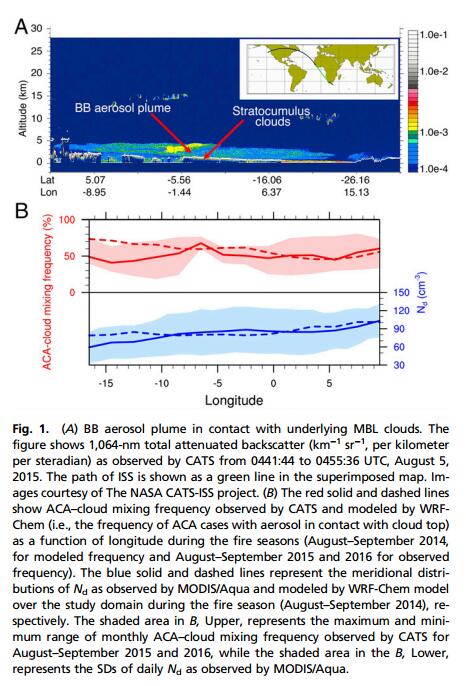最新科研进展
Biomass smoke from southern Africa can significantly enhance the brightness of stratocumulus over the southeastern Atlantic Ocean
Authors:
Zheng Lua, Xiaohong Liua,b,1, Zhibo Zhangc,d, Chun Zhaoe, Kerry Meyerf, Chamara Rajapakshec, Chenglai Wua,b, Zhifeng Yangc,d, and Joyce E. Pennerg
a Department of Atmospheric Science, University of Wyoming, Laramie, WY 82071; b International Center for Climate and Environment Sciences, Institute of Atmospheric Physics, Chinese Academy of Sciences, Beijing 100029, China; c Physics Department, University of Maryland Baltimore County, Baltimore, MD 21250; d Joint Center for Earth Systems Technology, University of Maryland Baltimore County, Baltimore, MD 21250; e School of Earth and Space Sciences, University of Science and Technology of China, Hefei 230026, China; f Climate and Radiation Laboratory, NASA Goddard Space Flight Center, Greenbelt, MD 20771; and g Department of Climate and Space Sciences and Engineering, University of Michigan, Ann Arbor, MI 48109
Abstract:
Marine stratocumulus clouds cover nearly one-quarter of the ocean surface and thus play an extremely important role in determining the global radiative balance. The emipermanent marine stratocumulus deck over the southeastern Atlantic Ocean is of particular interest, because of its interactions with seasonal biomass burning aerosols that are emitted in southern Africa. Understanding the impacts of biomass burning aerosols on stratocumulus clouds and the implications for regional and global radiative balance is still very limited. Previous studies have focused on assessing the magnitude of the warming caused by solar scattering and absorption by biomass burning aerosols over stratocumulus (the direct radiative effect) or cloud adjustments to the direct radiative effect (the semidirect effect). Here, using a nested modeling approach in conjunction with observations from multiple satellites, we demonstrate that cloud condensation nuclei activated from biomass burning aerosols entrained into the stratocumulus (the microphysical effect) can play a dominant role in determining the total radiative forcing at the top of the atmosphere, compared with their direct and semidirect radiative effects. Biomass burning aerosols over the region and period with heavy loadings can cause a substantial cooling (daily mean?8.05 W m ?2), primarily as a result of clouds brightening by reducing the cloud droplet size (the Twomey effect) and secondarily through modulating the diurnal cycle of cloud liquid water path and coverage (the cloud lifetime effect). Our results highlight the importance of realistically representing the interactions of stratocumulus with biomass burning aerosols in global climate models in this region.
Key words:
stratocumulus clouds | biomass burning aerosols | aerosol–cloud interaction

Citation:
, ,
